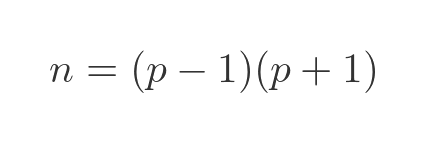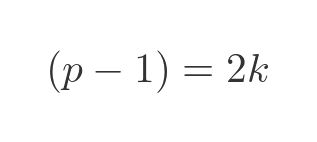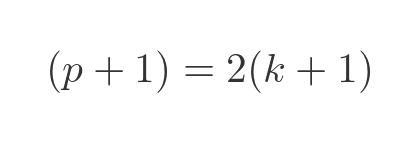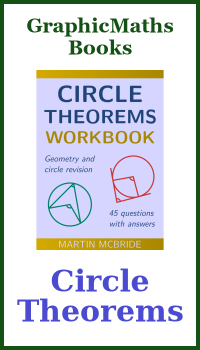Factors of a prime squared minus 1
Categories: recreational maths problems

This is a past question from the Cambridge University Maths entrance interview. It is an interesting open-ended question with quite a surprising result. Consider the following value n:

Where p is a prime number greater than 3.
The question is: what can you say about the prime factors of n?
Think about it before looking at the answer.
Tackling the problem
Since this is a question about the prime factors of n, a good place to start might be to factorise n itself. We can see that n is a difference of two squares:

This can be factorised into:

So we now have the slightly easier problem of finding the prime factors of (p - 1) and (p + 1).
What can we tell about the factors?
What do we know about the two factors? There are two obvious things we can say:
- (p - 1) and (p + 1) differ by 2.
- (p - 1), p, and (p + 1) are consecutive.
Not forgetting, of course, we have been told that p is prime and greater than 3.
Finding the factors
Clearly at least one of (p - 1), p, and (p + 1) must be even, because they are consecutive.
But we know that p is a prime, and it isn't 2 (because it is greater than 3). This means that (p - 1) and (p + 1) must both be even.
So both factors are divisible by 2:

We can therefore say that n is divisible by 4.
But we can find out a bit more. Since (p - 1) is even we can write it as:

And since (p + 1) is 2 greater than (p - 1) we can write it as:

Now either k or k + 1 must be even. This means that exactly one of (p - 1) or (p + 1) must be divisible by 4 (the other is only divisible by 2).
So, n is not only divisible by 4, it is actually divisible by 8.
Another factor
That is not all, we can find another factor. Since (p - 1), p, and (p + 1) are consecutive, exactly one of those numbers must be divisible by 3. And we know that p cannot be divisible by 3, because it is a prime number greater than 3.
This means that exactly one of (p - 1) or (p + 1) must be divisible by 3. So, n is not only divisible by 8, it is also divisible by 3.
The result
This gives us the result that any number of the form:

where p is a prime number greater than 3, is divisible by 24.
Let's check that
Let's try a few values.
5 squared is 25. Subtract 1 gives 24.
7 squared is 49. Subtract 1 gives 48 (2 times 24).
11 squared is 121. Subtract 1 gives 120 (5 times 24).
Let's try a bigger prime:
1237 squared is 1530169. Subtract 1 gives 1530168 (63757 times 24).
Did you figure it out?
Related articles
Join the GraphicMaths Newsletter
Sign up using this form to receive an email when new content is added to the graphpicmaths or pythoninformer websites:

Popular tags
adder adjacency matrix alu and gate angle answers area argand diagram binary maths cardioid cartesian equation chain rule chord circle cofactor combinations complex modulus complex numbers complex polygon complex power complex root cosh cosine cosine rule countable cpu cube decagon demorgans law derivative determinant diagonal directrix dodecagon e eigenvalue eigenvector ellipse equilateral triangle erf function euclid euler eulers formula eulers identity exercises exponent exponential exterior angle first principles flip-flop focus gabriels horn galileo gamma function gaussian distribution gradient graph hendecagon heptagon heron hexagon hilbert horizontal hyperbola hyperbolic function hyperbolic functions infinity integration integration by parts integration by substitution interior angle inverse function inverse hyperbolic function inverse matrix irrational irrational number irregular polygon isomorphic graph isosceles trapezium isosceles triangle kite koch curve l system lhopitals rule limit line integral locus logarithm maclaurin series major axis matrix matrix algebra mean minor axis n choose r nand gate net newton raphson method nonagon nor gate normal normal distribution not gate octagon or gate parabola parallelogram parametric equation pentagon perimeter permutation matrix permutations pi pi function polar coordinates polynomial power probability probability distribution product rule proof pythagoras proof quadrilateral questions quotient rule radians radius rectangle regular polygon rhombus root sech segment set set-reset flip-flop simpsons rule sine sine rule sinh slope sloping lines solving equations solving triangles square square root squeeze theorem standard curves standard deviation star polygon statistics straight line graphs surface of revolution symmetry tangent tanh transformation transformations translation trapezium triangle turtle graphics uncountable variance vertical volume volume of revolution xnor gate xor gate
